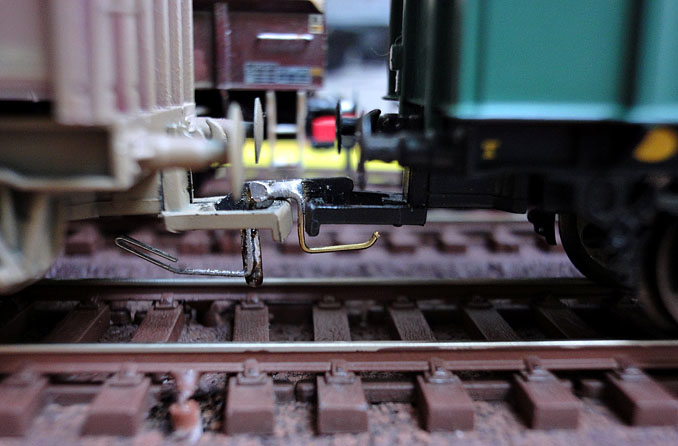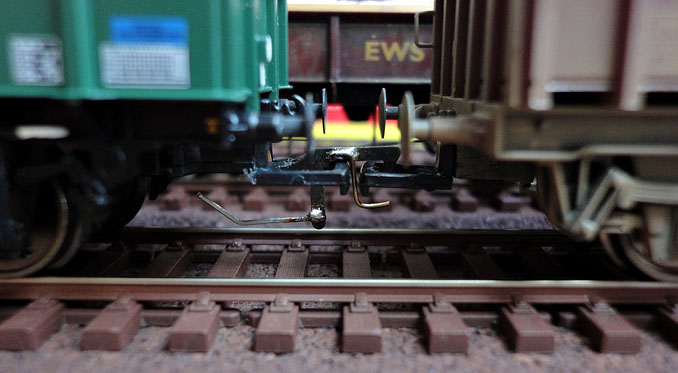Part of the reason for slow progress on Whitemarsh Yard is that I've been held up by needing to get reliable working couplings and install uncouplers before ballasting can go ahead.

I did some experiments with Brian Kirby's magnetic tension locks and came away quite happy, but when I started thinking about siting magnets I was less happy - even for a small layout like Whitemarsh you need quite a few. Plus because I didn't install them before laying the track, each uncoupler requires cutting out two sleepers, fitting two magnets, and making good afterwards. Not heaps of work, but not trivial either.
I wondered about some kind of delayed action and remembered that Christopher Payne mentioned using "delayed action tension locks" for his minimum gauge layouts. He describes the system here (apparently he was in turn inspired by an article in the March 1969 Railway Modeller) and it's very elegant, much like the magnetic system in that respect. So... could these two neat ideas work together? On the face of it it looked reasonable, so I modified some coupling hooks and tried them out. Essentially this meant fitting a brass wire delay latch to the coupling hook to sit outboard of the bar, plus notching the underside of the bars in the middle.
How it works (assuming a loco coupled to a wagon for the sake of avoiding "wagon A", "wagon B" etc.)
- When the coupling is over the magnet and tension is released, the hook lifts until the latch catches under the bar of the other coupling.
- Backing the loco off, the bar slides over the latch and hook lifts fully.
- Bringing the loco back, and propelling the wagon away from the magnet, the hook drops partially and the latch sits on top of the loco's bar.
- You can then propel the wagon to where you want to drop it off.
- Backing the loco off again, the latch slides over the bar and the hook returns to normal.
This all worked fairly well, so naturally I looked for ways to spoil it ![]() The big difference between the magnetic tension locks and the ramp-operated kind is that the hooks lift much further with the magnets - with the neodymium magnets I'm using, the hooks lift easily to the limit of their travel, and I recall this was also the case with the recommend cupboard door catch magnets as well. This makes it both possible to use a simpler latch, and not necessary to notch the loops. I think when using ramps the hooks don't lift as far, so the geometry of the latch, hook and loop is a lot tighter hence the more complex shape. I also didn't bother to crank the hooks to the centre line on the second try. This resulted in a Mark 2 simplified version:
The big difference between the magnetic tension locks and the ramp-operated kind is that the hooks lift much further with the magnets - with the neodymium magnets I'm using, the hooks lift easily to the limit of their travel, and I recall this was also the case with the recommend cupboard door catch magnets as well. This makes it both possible to use a simpler latch, and not necessary to notch the loops. I think when using ramps the hooks don't lift as far, so the geometry of the latch, hook and loop is a lot tighter hence the more complex shape. I also didn't bother to crank the hooks to the centre line on the second try. This resulted in a Mark 2 simplified version:

It's not a huge difference, but forming the hook is easier, it's marginally less obtrusive, and not having to notch the loops makes installation less fiddly. (Ignore the different staple arrangement here - that was another experiment).
Footnotes:
I soldered the magnetic tail and delay latch, not something I'm very good at but so far they haven't fallen off. I didn't have any problems with soldering one desoldering the other.
I'm currently using the delayed action couplings single-ended (so the hooks are only at one end). This makes installing magnets easier, since you only need one, but it does mean things have to be fitted more accurately (mainly in regard to mounting height) since you can't rely on the "other" hook to provide tension if one doesn't quite catch the loop properly. I don't think this is peculiar to the modified couplings though.
I can't see why the delayed action wouldn't work with hooks at both ends, but it would be likely better done as a one piece etched arm since I perhaps the delay latches (which effectively make the arms thicker) interfering with each other. I might try and fit the latches on the reverse and see if that works - if it does, then using the couplings double-ended is attractive since it will allow stock to run on any layout, and locos to wear thin wire loops rather than tension locks at both ends.
The delayed action and non-delayed action magnetic couplers inter-operate quite well, rather like the way the magnetic and "vanilla" tension locks do, so no rush to convert everything.
Disclaimer:
Unlike Christopher and Brian, I haven't tested this modification extensively under proper layout conditions (although I intend to) so take this as an interesting suggestion rather than a recommendation ![]() If it turns out that it all goes really well though, does anyone fancy making an etch with the latches built in?
If it turns out that it all goes really well though, does anyone fancy making an etch with the latches built in?



3 Comments
Recommended Comments
Create an account or sign in to comment
You need to be a member in order to leave a comment
Create an account
Sign up for a new account in our community. It's easy!
Register a new accountSign in
Already have an account? Sign in here.
Sign In Now